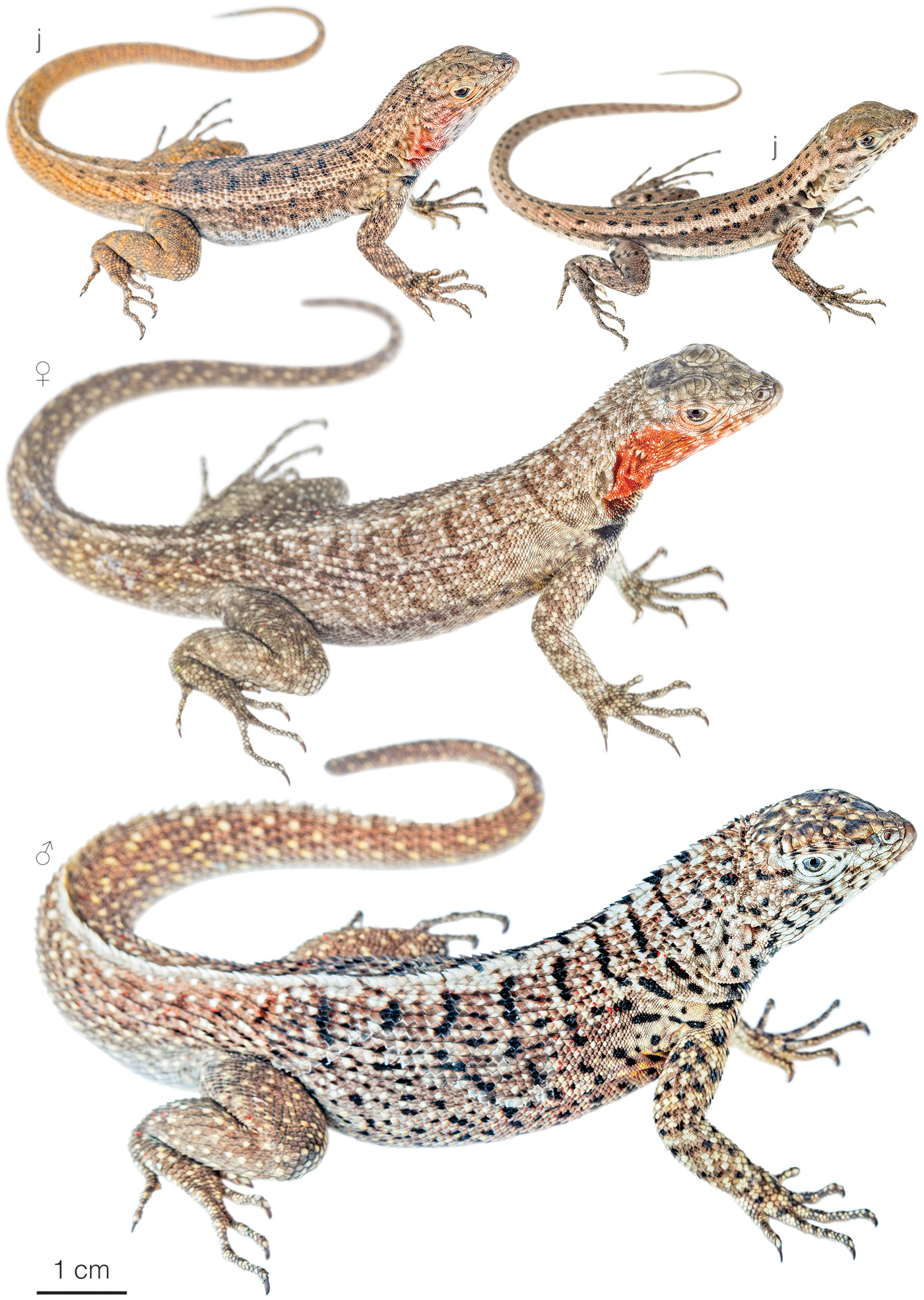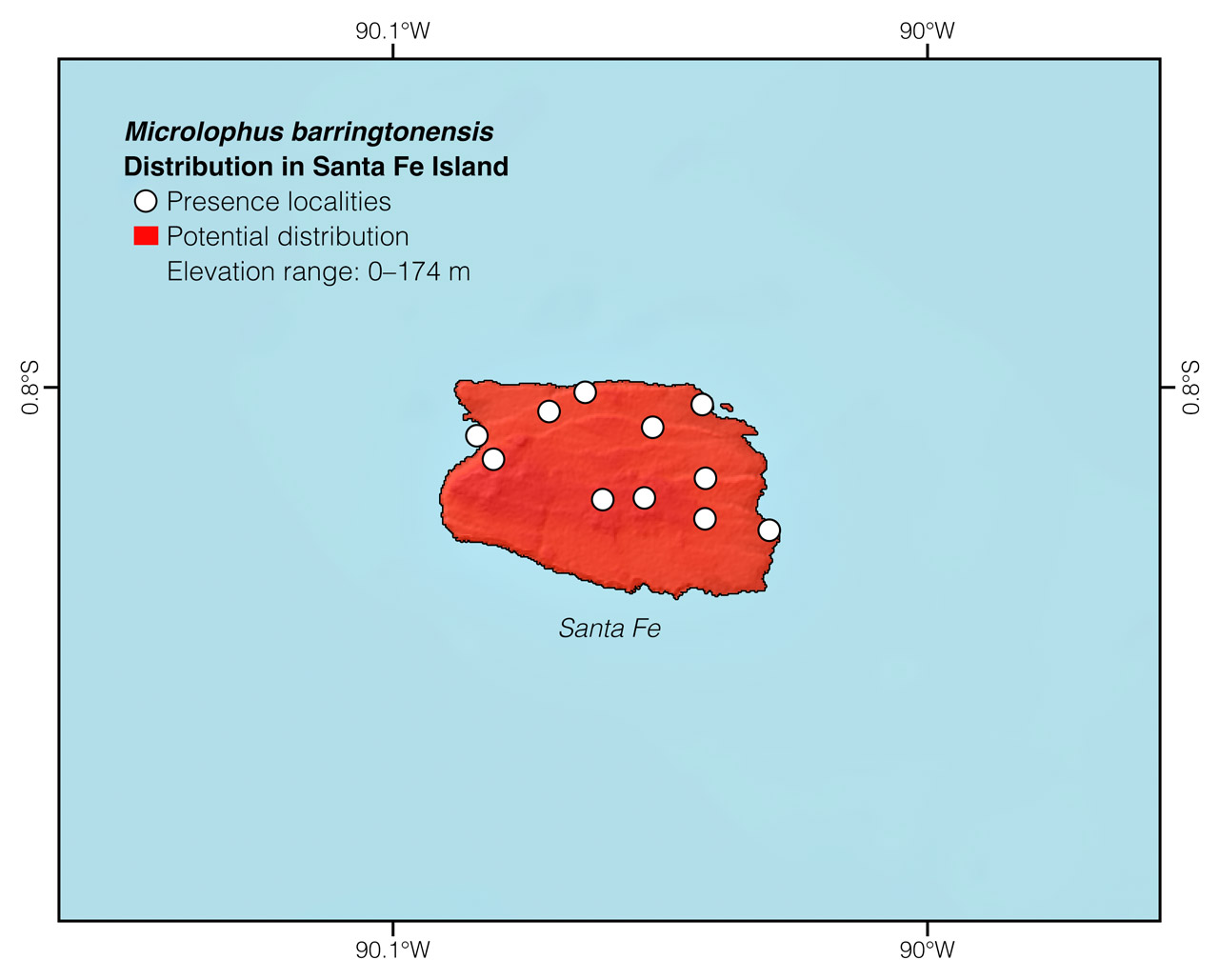Published October 10, 2019. Updated January 20, 2024. Open access. Peer-reviewed. | Purchase book ❯ |
Santa Fe Lava-Lizard (Microlophus barringtonensis)
Reptiles of Ecuador | Sauria | Tropiduridae | Microlophus barringtonensis
English common names: Santa Fe Lava-Lizard, Barrington Lava-Lizard.
Spanish common name: Lagartija de lava de Santa Fe.
Recognition: ♂♂ 28.1 cmMaximum distance from the snout to the tip of the tail. Snout–vent length=9.5 cm. ♀♀ 20.2 cmMaximum distance from the snout to the tip of the tail..1,2 Microlophus barringtonensis is easily distinguishable from other lizards occurring on Santa Fe Island (that is, iguanas and leaf-toed geckos) by having keeled scales on the tail, a skin fold above the shoulder, a raised mid-dorsal crest, and a conspicuously enlarged interparietal scale. Microlophus barringtonensis is the only lava lizard occurring on Santa Fe Island. Males and females of this species differ from each other in size, shape, and coloration.1,2 Adult males are larger and easily recognizable by their raised middorsal crest. They also have a brownish body with scattered black blotches and white spots, as well as a distinctive black throat and a black chest (Fig. 1). Adult females have bright orange cheek patches and a black mark at the shoulder level.

Figure 1: Individuals of Microlophus barringtonensis from El Miedo, Santa Fe Island, Galápagos province, Ecuador. j=juvenile.
Natural history: Microlophus barringtonensis is a diurnal lizard that occurs in high densities in volcanic rock areas, dry shrublands, and deciduous forests of Santa Fe Island.1 Santa Fe Lava-Lizards bask and move on soil, rocks, and cacti up to 1.7 m above the ground.1 They move into the shade to avoid the hottest hours of the day, sitting on surfaces that have not been heated by the sun. At night, they remain hidden among rocks, beneath soil, and under leaf-litter. Their diet is insectivorous and consists primarily of grasshoppers3 and maggots,4 but also includes geckos (Phyllodactylus barringtonensis) and seeds.5 When threatened, these jittery reptiles flee into crevices. If captured, they may shed the tail and bite.1 There are recorded instances of predation on members of this species by snakes (Pseudalsophis dorsalis).1 Males of M. barringtonensis defend territories by performing pushup displays and fighting with other males.1 Females lay three eggs per clutch.4
Conservation: Near Threatened Not currently at risk of extinction, but requires some level of management to maintain healthy populations..1 Microlophus barringtonensis is listed in this category because the species is not undergoing population declines or facing major immediate threats of extinction. Santa Fe Island is not populated by humans and is protected within the Galápagos National Park. However, since the Santa Fe Lava-Lizard is restricted to a small island, it could be severely affected by random unpredictable events (like droughts and introduced species) within a short time period.
Distribution: Microlophus barringtonensis is endemic to Santa Fe Island (Fig. 2) in Galápagos, Ecuador. Santa Fe is a small and relatively flat island with an area of 24 km2 and a maximum elevation of 250 m above sea level (Fig. 3). The vegetation of the island is dominated by the palo santo tree (Bursera graveolens) and the giant prickly pear cactus.

Figure 2: Distribution of Microlophus barringtonensis in Galápagos. See Appendix 1 for a complete list of the presence localities included in the map.

Figure 3: Distribution of Microlophus barringtonensis in Santa Fe Island. See Appendix 1 for a complete list of the presence localities included in the map.
Etymology: The generic name Microlophus comes from the Greek words mikros (=small) and lophos (=crest).1 The specific epithet barringtonensis refers to Santa Fe, previously known as Barrington Island.
See it in the wild: Santa Fe Lava-Lizards can be seen year-round with complete certainty during tourism day trips to Santa Fe Island. The best time to look for, and photograph, them is during the first hours after sunrise or right before sunset, when the lizards are active and approachable.
Special thanks to Ellen Smith for symbolically adopting the Santa Fe Lava-Lizard and helping bring the Reptiles of Ecuador book project to life.
Click here to adopt a species.
Authors: Alejandro ArteagaaAffiliation: Fundación Khamai, Reserva Arlequín, Ecoruta Paseo del Quinde km 56, Santa Rosa de Mindo, Pichincha 171202, Ecuador. and Juan M GuayasaminbAffiliation: Universidad San Francisco de Quito, Quito, Ecuador.
Academic reviewers: Edgar Benavides,cAffiliation: Yale University, New Have, USA. John Rowe,dAffiliation: Alma College, Alma, USA. and Cruz MárquezeAffiliation: University of Rome Tor Vergata, Rome, Italy.
Photographer: Alejandro ArteagaaAffiliation: Fundación Khamai, Reserva Arlequín, Ecoruta Paseo del Quinde km 56, Santa Rosa de Mindo, Pichincha 171202, Ecuador.
How to cite? Arteaga A, Guayasamin JM (2024) Santa Fe Lava-Lizard (Microlophus barringtonensis). In: Arteaga A, Bustamante L, Vieira J (Eds) Reptiles of Ecuador: Life in the middle of the world. Available from: www.reptilesofecuador.com. DOI: 10.47051/OJGQ3553
Literature cited:
- Arteaga A, Bustamante L, Vieira J, Tapia W, Guayasamin JM (2019) Reptiles of the Galápagos: life on the Enchanted Islands. Tropical Herping, Quito, 208 pp. DOI: 10.47051/AQJU7348
- Baur G (1892) Das Variieren der Eidechsen-Gattung Tropidurus auf den Galapagos-Inseln und Bemerkungen über den Ursprung der Inselgruppe. Biologisches Zentralblatt 10: 475–483.
- Van Denburgh J, Slevin JR (1913) Expedition of the California Academy of Sciences to the Galápagos Islands, 1905-1906. IX. The Galapagoan lizards of the genus Tropidurus with notes on iguanas of the genera Conolophus and Amblyrhynchus. Proceedings of the California Academy of Sciences 2: 132–202.
- Carpenter CC (1970) Miscellaneous notes on Galápagos lava lizards (Tropidurus: Iguanidae). Herpetologica 26: 377–386.
- Washington Tapia, unpublished data.
Appendix 1: Locality data used to create the distribution map of Microlophus barringtonensis in Ecuador (Fig. 2). Go to the section on symbols and abbreviations for a list of acronyms used.
| Country | Province | Locality | Source |
| Ecuador | Galápagos | Bahía | Arteaga et al. 2019 |
| Ecuador | Galápagos | Bahía, 500 m SW of | iNaturalist; photo examined |
| Ecuador | Galápagos | Barrington Bay | iNaturalist; photo examined |
| Ecuador | Galápagos | Barrington Bay, 1 km SW of | iNaturalist; photo examined |
| Ecuador | Galápagos | Barrington Bay, 1.5 km S of | iNaturalist; photo examined |
| Ecuador | Galápagos | El Miedo | Arteaga et al. 2019 |
| Ecuador | Galápagos | Encañada | Arteaga et al. 2019 |
| Ecuador | Galápagos | Halfway along Encañada | Arteaga et al. 2019 |
| Ecuador | Galápagos | Land Iguana trail | iNaturalist; photo examined |
| Ecuador | Galápagos | Land Iguana trail, 1 km W of | iNaturalist; photo examined |
| Ecuador | Galápagos | Meseta central | iNaturalist; photo examined |